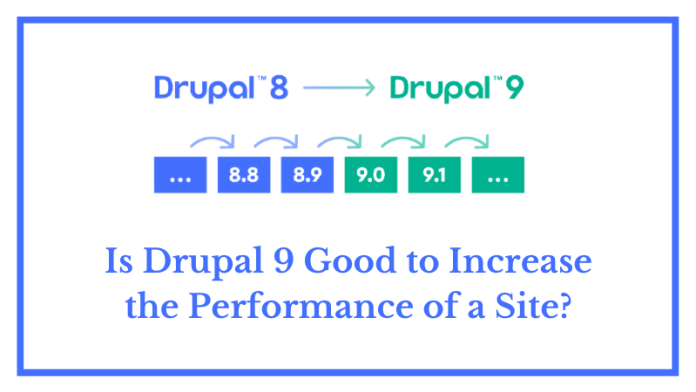
Drupal 9 was released in June 2020 and ever since people have been discussing its performance statistics. The question is whether or not Drupal 9 is useful for optimized web development. Should one migrate to Drupal 9 to improve their website’s performance?
Drupal 9 update didn’t include any additional features than its predecessor update 8.9 and yet has entirely contributed to the website’s upgraded performance. One of the most significant reasons for this is the cleaner code base of Drupal.
There is a vast history of Drupal and the new Drupal 9 beta version has announced removing all the deprecated codes of Drupal 8 or earlier versions. Therefore, if the websites created on Drupal 8 need to be compatible with the Drupal 9 version, they have to get rid of the deprecated codes. This ensures better website performance.
Moreover, Drupal 9 can be considered a continuation of the stable Drupal version 8 but with a cleaner codebase. You can also look at the factors mentioned below that ensure Drupal 9 boosts the website’s performance significantly.
How Drupal 9 Impacts Your Website Performance?
Quick page loading with Caching, Bigpipe, and Redis
Page caching is one of the most used techniques for reducing page loading speed. It is helpful when a user needs to load frequently visited pages. In such a case, caching helps because the page doesn’t have to go through an entire page generation cycle and is fetched from cache memory instead.
However, this was not possible for dynamic pages that present personalized information for users. Drupal 9 aims for performance optimization with the introduction of modules such as Bigpipe. This is a part of the Drupal core module and helps to cache dynamic pages as well. Here, the dynamic content or dynamic portion of the page is separated into a different section that loads separately whenever a user tries to access a page. This helps reduce the page loading time significantly.
Drupal mostly relies on caching objects and storing them in a database for high-speed page loading. However, it can cause issues in high-traffic websites as the same database is being used for multiple other queries, and a deadlock can occur. One can use the Redis module to avoid falling prey to such situations. It can be used as a replacement for the caching database and help improve the site’s performance.
Image API Optimization
We often commit this mistake of uploading original size images on a website and end up lowering the site speed. Drupal 9 allows the use of modules such as ”Image Optimize” that can be used to get perfectly balanced images (Performance and quality). You don’t have to worry about the image size affecting page speed or about the poorly looking images.
Furthermore, users can also use a responsive image module to make the images responsive. It will ensure that the images load correctly depending upon the screen size of your device. The concept of ”Lazy loaded images” is also an advantage for websites and can improve the performance. Here, an image isn’t loaded until the user scrolls down to the place where the image is located. So, the image needs to be loaded if the user scrolls till that point, otherwise not. This significantly improves the site’s performance.
However, one needs to have access to quality Drupal development services to utilize the various modules and Drupal 9 features well. It will ensure their web site’s performance is optimized, and visitors can smoothly navigate the site.
Content Delivery Network (CDN)
A CDN or Content Delivery Network comprises several servers spread worldwide that stores static copies of your website content. This is highly efficient in loading web pages quickly as the local static copies from the CDN nearest to a user is fetched. This ensures that the content or webpage is readily available whenever a user tries to access it. The use of CDN eliminates any chances of lag in page loading and helps increase the website performance.
Improved Security
Since the Drupal 9 upgrade has removed the provision for any deprecated codes of Drupal version 7 and 8, the third-party dependencies are reduced. This automatically improves the performance and security of websites built with the Drupal 9 version.
Backward Compatibility
Backward compatibility means that Drupal 9 is compatible with its predecessor Drupal 8. They will share a common codebase, and most of Drupal 8 modules will be compatible with the newly released version of Drupal 9. It enables Drupal 8 users to use Drupal 9 without any hassle.
However, developers have to remove deprecated codes to maintain compatibility with Drupal 9. It will also ensure a cleaner codebase and improve your site’s performance to a great extent.
Upgraded versions of Twig and Symphony
Drupal 9 is likely to include an upgraded version of framework Symphony 3 and Twig 2.0. The upgraded versions of the framework are likely to improve the website’s performance and overall development experience. Developers will be exposed to more creative and intricately designed themes in addition to the customization opportunities.
In any case, the Drupal 9 upgrade is emerging to be one of the stable most upgrades. The primary reason is inheriting all the stable features of Drupal 8 while focusing on cleaning the deprecated codes. It helped developers create more engaging, professional, and futuristic websites using Drupal.
However, if one is planning to migrate to Drupal 9, they must diagnose the deprecated codes and clean it. This, of course, needs intricate technical proficiency, and one will need seasoned developers for the job. Contacting a professional Drupal development company will help you significantly in such a time. Auxesis Infotech is one such organization that helps develop fast, responsive, and futuristic websites as per the client’s requirements. The skilled team of developers, designers, and testers ensures every piece of advice is taken into consideration.








